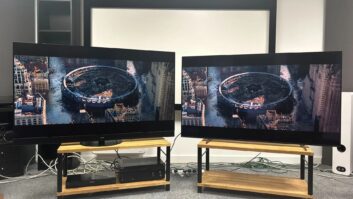New York — Citing expected growth in sales of plasma display televisions, and increased price compression on the category, Panasonic’s display group VP Ed Wolff said his company will cease production of CRT-based rear projection televisions by March 2005.
“As plasma prices come down, microdevice [rear-projection TV] prices come down, and they are going to start to crush the CRT-based prices,” Wolff said, speaking at his company’s “Seeing Is Believing” media event here. “I know there is still a good [price] gap in one or two places, but it is going to get closer and closer.
“Our plant in Mexico is going to start assembling plasma and LCD products,” he continued. “I’d rather they be doing that than continuing to build a technology I know is going to be gone in a couple of years.”
At the same time, the company will continue to manufacturer microdisplay based rear-projection televisions — based on both LCD and DLP technologies — while expanding its assortment in flat-panel plasma and LCD TVs, Wolff said.
He added that all of Panasonic’s microdisplay rear-projection television manufacturing will be performed in the company’s former TV/VCR combo plant in Vancouver, WA.
Panasonic will continue to manufacturer CRT-based direct-view products for the foreseeable future.
Key company executives celebrated Panasonic’s recent market share gaines in the plasma category — Wolff cited Display Search market research showing Panasonic as the plasma TV market share leader in “the most recent quarter” — and sought to clarify some popular misconceptions about plasma display technology.
Wolff said Panasonic focus group studies revealed that consumers remain highly excited by the form-factor and picture quality that some plasma displays offer, but continue to falsely believe that all plasma televisions have significantly shorter life expectancies than CRT or LCD TVs and are more vulnerable to on-screen image burn-in.
Jeff Cove, Panasonic’s strategic alliances and business development VP, said “the myths” about plasma displays having shorter life spans and greater vulnerability to on-screen image burn-in came from early generation models, which have been enhanced and improved to correct the problems.
Today, he said, Panasonic’s plasma displays have little more risk of burn-in than CRT direct-view sets, and should enjoy a 60,000-hour life span, which is the equivalent to many CRT displays.
Cove added that in average use, the power consumption of plasma panels is not dramatically different than LCD TVs.
In addition, he said plasma panels offer higher contrast performance than LCD TVs, a wider viewing angle than either direct-view LCD or rear-projection televisions and high color performance.













